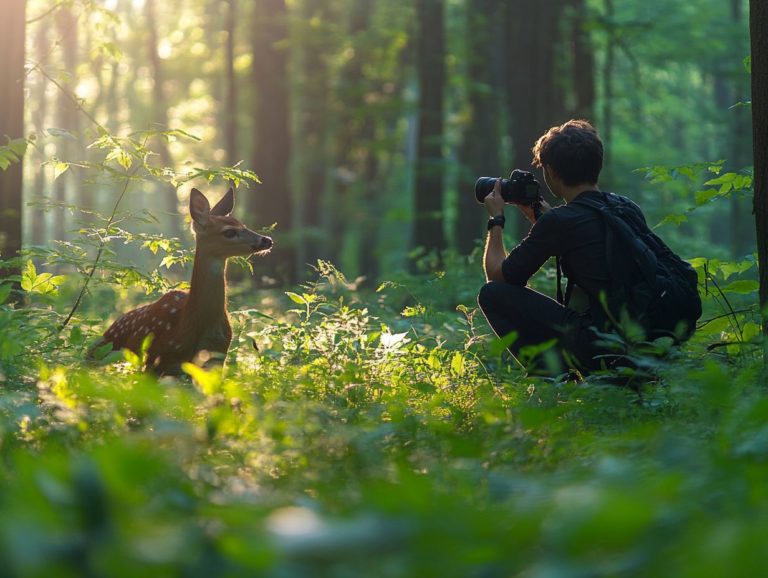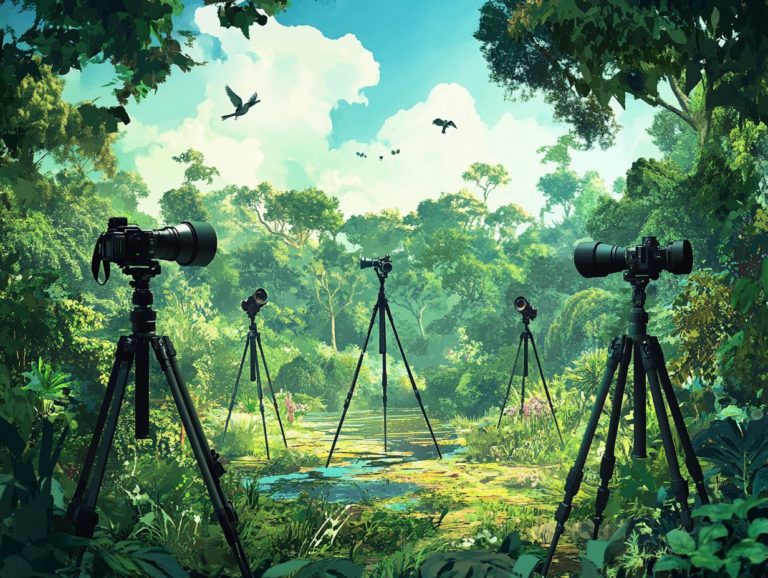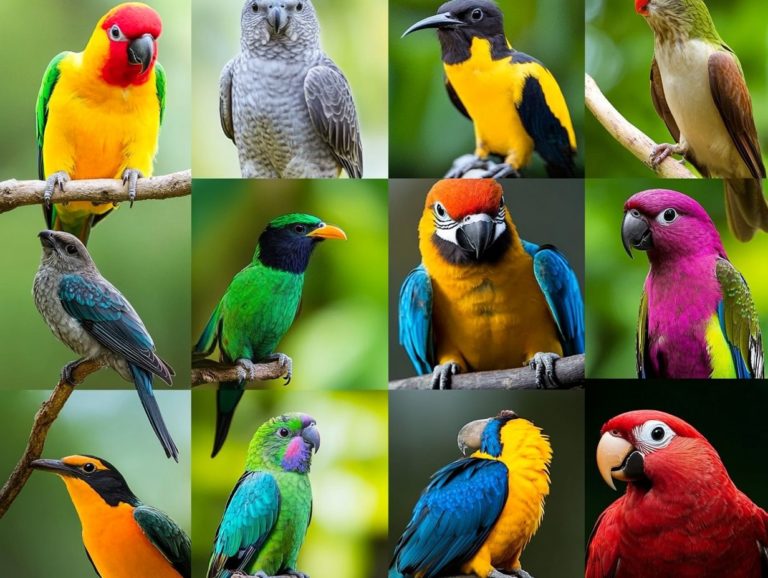How to Capture Bird Behavior on Camera
Capturing the intricate behaviors of birds is a rewarding endeavor that beautifully blends art with nature observation. This guide will illuminate essential aspects of bird photography, guiding you through everything from understanding various bird behaviors to selecting the right camera equipment.
You will discover optimal settings and techniques tailored for your shoots. Uncover the best locations and times to engage with your subjects. Strategies for photographing captivating behaviors, such as feeding and nesting, will be explored in depth.
We emphasize the importance of ethical practices to ensure the protection of these magnificent creatures. Whether you’re just starting out or seeking to refine your skills, get ready to capture breathtaking photos of birds that will amaze your friends and family!
Contents
- Key Takeaways:
- Understanding Bird Behavior
- Choosing the Right Camera Equipment
- Setting Up Your Camera for Bird Photography
- Location and Timing for Bird Photography
- Techniques for Capturing Different Bird Behaviors
- Tips for Getting the Perfect Shot
- Respecting and Protecting Birds in the Wild
- Frequently Asked Questions
- 1. What is the best way to capture bird behavior on camera?
- 2. How can I make my bird behavior footage more interesting?
- 3. What time of day is best for capturing bird behavior on camera?
- 4. How can I attract specific bird species to my camera setup?
- 5. What equipment do I need to successfully capture bird behavior on camera?
- 6. Are there any ethical guidelines I should follow when filming bird behavior?
Key Takeaways:

- Learn bird behaviors to capture unique moments effortlessly!
- Choose a camera with features specifically designed for bird photography for better results.
- Set up your camera with optimal settings and techniques, and pick the right location and timing for the best chance at capturing bird behavior.
Understanding Bird Behavior
Grasping bird behavior is essential for any aspiring photographer aiming to master the art of bird photography. By observing how birds engage with their environment, you increase your chances of capturing them in striking poses. For additional insights, check out this guide on how to safely photograph birds in the wild.
This insight not only elevates the overall quality of your wildlife photography but also respects the natural habitats of these creatures. Understanding various bird behaviors such as feeding, mating, and social interactions enables you to identify the best locations and times for effective photographing birds with different backgrounds.
Types of Bird Behavior
Birds display a remarkable array of behaviors that can be categorized into feeding, mating, and social interactions. Each provides distinct opportunities for your wild bird photography.
Feeding behaviors range from the delicate pecking of a hummingbird sipping nectar to the lively hustle of a flock of sparrows foraging for seeds. To photograph these moments effectively, consider using a telephoto lens (a lens that allows you to take pictures from far away) or a mirrorless full-frame camera (a type of camera that captures high-quality images in a compact form).
Pair that with a fast shutter speed to freeze their rapid movements. Mating displays, such as intricate dances of courtship, offer incredible opportunities for visual storytelling. Utilizing a quick burst mode can help you capture these ephemeral interactions.
Observing social behaviors, like flocking or preening, can lead to captivating group shots. Your patience and understanding of seasonal movements and local ecosystems will be invaluable in anticipating these behaviors.
Choosing the Right Camera Equipment
Selecting the right camera equipment is crucial for any photographer aspiring to excel in bird photography. Capturing birds in flight and other dynamic behaviors depends on choosing the ideal lens types and camera bodies.
With technology advancing rapidly, mirrorless full-frame cameras from brands like Nikon, Canon, Sony, Olympus, and Fuji have become favorites among wildlife photographers. Opt for the right focal length and a long lens to enhance your ability to photograph birds from a distance without disturbing them.
Making informed choices in this area is vital for achieving success in wildlife photography.
Share your bird photography journey with us and inspire others!
Features and Functions for Capturing Bird Behavior
To capture bird behavior effectively, your camera’s features are crucial. Important settings include shutter speed, autofocus, and burst mode. If you’re looking to enhance your skills, check out this guide on how to get started with bird photography.
These elements impact the clarity of your shots and the timing. A shutter speed of at least 1/2000th of a second is key for fast-moving birds, ensuring their wings are captured in sharp detail.
An advanced autofocus system helps you lock onto subjects in unpredictable environments. Burst mode allows you to take a rapid series of shots, great for capturing quick actions like a bird taking off.
By combining these settings with post-processing techniques, you can document the stunning intricacies of bird life in your photos.
Setting Up Your Camera for Bird Photography

Setting up your camera for bird photography requires knowing the best settings to match the fast movements of birds. Additionally, learning how to create stunning bird portraits using effective composition techniques can elevate the visual appeal of your shots.
Optimal Camera Settings and Techniques
To take stunning bird photos, adjust your camera settings carefully. Key settings include shutter speed, aperture, and ISO levels.
Birds show various behaviors, from hovering to sitting still, each requiring different settings. For action shots, use a fast shutter speed of at least 1/1000s. If a bird is resting, a slower shutter speed can create a serene image.
The aperture controls the depth of field. A wider aperture beautifully isolates your subject against a soft background. Adjust the ISO based on lighting, especially in low-light situations, to ensure clarity in your images.
Location and Timing for Bird Photography
Location and timing are crucial for successful bird photography. Knowing the best spots and times to photograph birds can greatly improve your chances of capturing breathtaking images.
Best Places and Times to Capture Bird Behavior
To find the best locations and times for bird behavior, understand your local ecosystems, seasonal migrations, and birdwatching hotspots. Renowned wetlands like the Everglades or Chesapeake Bay marshes are great places to see wading birds.
Other excellent spots include lush forests in the Great Smoky Mountains during migration seasons. Even urban parks like Central Park in New York City can surprise you with birding opportunities.
Maximize your shoot by going out during early morning or late afternoon. Birds are most active then, and the light conditions highlight their vibrant colors.
Techniques for Capturing Different Bird Behaviors
Capturing various bird behaviors like flight, feeding, and nesting is essential. To enhance your skills, learn how to capture bird calls with your camera as these techniques help showcase the unique character of birds in your photography.
By refining these techniques, you can create dynamic imagery that truly captures the essence of your avian subjects.
Strategies for Photographing Flight, Feeding, and Nesting

Successful strategies for photographing flight, feeding, and nesting demand a blend of patience, insight into bird behavior, and the right gear to capture each moment in all its glory.
To elevate your chances of securing that perfect shot, consider investing in a high-quality telephoto lens. This allows you to maintain a respectful distance while still achieving remarkable detail.
Scouting locations ahead of time is essential. Delve into areas where birds congregate think wetlands or parks and become familiar with their routines.
Timing is everything! Capture those golden hours shortly after sunrise and before sunset for the best natural light and peak activity levels in wild bird photography.
By staying quiet and observant, you can seamlessly blend into the environment, making it easier to capture the most intimate moments of avian life without disrupting their natural behaviors.
Tips for Getting the Perfect Shot
Capturing the perfect shot in bird photography requires a combination of composition techniques, ideal lighting, and a wealth of patience. These are essential elements that transform an ordinary photograph into a breathtaking work of art.
Composition, Lighting, and Patience
In bird photography, the connection between composition, lighting, and patience is vital for crafting images that resonate with viewers.
To effectively capture the essence of your avian subjects, consider employing techniques like the rule of thirds, a popular technique that divides the frame into three equal parts, helping to balance the composition. Leading lines can guide the viewer s eye toward the bird, creating a sense of movement and engagement.
Don t underestimate the power of natural light; shooting during golden hours can intensify colors and shadows, adding remarkable depth to your images.
Waiting patiently for the perfect moment when the bird strikes an interesting pose or engages in captivating action is crucial for transforming an ordinary shot into a stunning masterpiece.
Respecting and Protecting Birds in the Wild
Respecting and protecting birds in the wild isn’t merely an ethical choice; it s a fundamental responsibility for you as a wildlife photographer.
By aligning your passion for bird photography with conservation efforts, you play a vital role in safeguarding these magnificent creatures. Your commitment enhances your craft and contributes meaningfully to the preservation of their natural habitats.
Ethical Considerations and Conservation Efforts
Ethical considerations and conservation efforts are paramount in wildlife photography. You must strike a delicate balance between your desire to capture breathtaking images and the responsibility of safeguarding bird habitats and behaviors.
This balancing act demands a profound understanding of the ecosystems you explore and a genuine commitment to minimizing your impact on the natural world. Prioritizing long lenses allows you to maintain a respectful distance, enabling you to observe wildlife without disrupting their routines.
You can significantly contribute to conservation by:
- Supporting organizations dedicated to habitat preservation,
- Sharing your work to raise awareness, and
- Participating in initiatives that promote sustainable practices.
By placing respect for nature at the forefront of your work, you not only create stunning visual narratives but also nurture a greater appreciation for wildlife. This can inspire others to take action in protecting these vulnerable environments.
Frequently Asked Questions

1. What is the best way to capture bird behavior on camera?
To capture bird behavior on camera, choose a great spot and be patient. For tips on getting the best shots, check out this guide on how to photograph migratory birds. Stay still and ready for those unexpected moments!
2. How can I make my bird behavior footage more interesting?
One way to make your bird behavior footage more interesting is to try out close-ups, wide shots, and fresh angles. This adds variety and excitement to your footage! Additionally, learning how to take photos while bird watching can also enhance your captures, allowing you to use slow motion or time-lapse to capture unique behaviors.
3. What time of day is best for capturing bird behavior on camera?
Birds are most active early morning or late afternoon. These times provide better lighting for filming and more chances to see lively behavior. Be sure to research specific species to know their peak activity times!
4. How can I attract specific bird species to my camera setup?
You can attract specific bird species by setting up food or water sources. Additionally, using bird calls or decoys can mimic the sounds and appearances of the birds you want to capture. Dive into your research to discover what birds love most!
5. What equipment do I need to successfully capture bird behavior on camera?
To successfully capture bird behavior, you will need a quality camera with a good zoom lens, a tripod or stabilizer, and a lot of patience. Additionally, learning techniques for photographing birds in flight can enhance your skills. Other helpful tools include a remote shutter release, extra memory cards and batteries, and a camouflage cover to hide your camera from wary birds.
6. Are there any ethical guidelines I should follow when filming bird behavior?
Yes, there are ethical guidelines to follow when filming bird behavior. Respect the birds and their natural habitats don t disturb or harm them for the sake of getting footage! Be sure to look into any laws or regulations regarding wildlife filming in your area.






